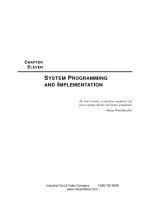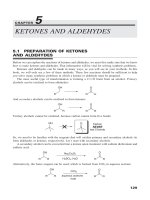Ebook Thoracic imaging - Pulmonary and cardiovascular radiology (3/E): Part 1
Bạn đang xem bản rút gọn của tài liệu. Xem và tải ngay bản đầy đủ của tài liệu tại đây (21.2 MB, 1,758 trang )
THORACIC IMAGING
Pulmonary and Cardiovascular
Radiology
Third Edition
2
THORACIC IMAGING
Pulmonary and Cardiovascular
Radiology
Third Edition
W. Richard Webb, MD
Professor Emeritus of Radiology and Biomedical Imaging
Department of Radiology and Biomedical Imaging
Emeritus Member, Haile Debas Academy of Medical Educators
University of California, San Francisco
San Francisco, California
Charles B. Higgins, MD
Distinguished Professor Emeritus of Radiology and Biomedical Imaging
Department of Radiology and Biomedical Imaging
University of California, San Francisco
San Francisco, California
3
Acquisitions Editor: Ryan Shaw
Product Development Editor: Lauren Pecarich
Marketing Manager: Dan Dressler
Production Project Manager: Priscilla Crater
Design Coordinator: Terry Mallon
Manufacturing Coordinator: Beth Welsh
Prepress Vendor: SPi Global
Third edition
Copyright © 2017 Wolters Kluwer
Copyright © 2011 Lippincott Williams & Wilkins, a Wolters Kluwer business. All rights reserved. This
book is protected by copyright. No part of this book may be reproduced or transmitted in any form or by
any means, including as photocopies or scanned-in or other electronic copies, or utilized by any
information storage and retrieval system without written permission from the copyright owner, except
for brief quotations embodied in critical articles and reviews. Materials appearing in this book prepared
by individuals as part of their official duties as U.S. government employees are not covered by the
above-mentioned copyright. To request permission, please contact Wolters Kluwer at Two Commerce
Square, 2001 Market Street, Philadelphia, PA 19103, via email at , or via our
website at lww.com (products and services).
987654321
Printed in China
Library of Congress Cataloging-in-Publication Data
Names: Webb, W. Richard (Wayne Richard), 1945- author. | Higgins, Charles B., author.
Title: Thoracic imaging : pulmonary and cardiovascular radiology / W. Richard Webb, Charles B.
Higgins.
Description: Third edition. | Philadelphia : Wolters Kluwer, [2017] | Includes bibliographical references
and index.
Identifiers: LCCN 2016033166 | ISBN 9781496321046 (hardback)
Subjects: | MESH: Lung Diseases—diagnosis | Cardiovascular Diseases—diagnosis | Radiography,
Thoracic—methods | Diagnostic Imaging—methods
Classification: LCC RC78.7.D53 | NLM WF 975 | DDC 616.07/54—dc23 LC record available at
/>This work is provided “as is,” and the publisher disclaims any and all warranties, express or implied,
including any warranties as to accuracy, comprehensiveness, or currency of the content of this work.
This work is no substitute for individual patient assessment based upon healthcare professionals’
examination of each patient and consideration of, among other things, age, weight, gender, current or
prior medical conditions, medication history, laboratory data and other factors unique to the patient. The
publisher does not provide medical advice or guidance and this work is merely a reference tool.
Healthcare professionals, and not the publisher, are solely responsible for the use of this work including
all medical judgments and for any resulting diagnosis and treatments.
Given continuous, rapid advances in medical science and health information, independent professional
verification of medical diagnoses, indications, appropriate pharmaceutical selections and dosages, and
treatment options should be made and healthcare professionals should consult a variety of sources.
When prescribing medication, healthcare professionals are advised to consult the product information
sheet (the manufacturer’s package insert) accompanying each drug to verify, among other things,
conditions of use, warnings and side effects and identify any changes in dosage schedule or
contraindications, particularly if the medication to be administered is new, infrequently used or has a
narrow therapeutic range. To the maximum extent permitted under applicable law, no responsibility is
4
assumed by the publisher for any injury and/or damage to persons or property, as a matter of products
liability, negligence law or otherwise, or from any reference to or use by any person of this work.
LWW.com
5
To Hideyo Minagi, my first teacher as a Resident, who taught me my most important lessons
—to recognize what is real and what is not—and to understand that not everything unusual
or abnormal is important. After that, it’s all gravy.
and
J, an exceptional big sister, who has helped me grow up in many ways.
—W. Richard Webb
To the many fellows who have contributed to our progress in developing new cardiovascular
imaging techniques.
—Charles B. Higgins
6
Contributors
Brett Elicker, MD
Associate Professor of Clinical Radiology
Chief, Cardiac and Pulmonary Imaging
Department of Radiology and Biomedical Imaging
University of California, San Francisco
San Francisco, California
Michael B. Gotway, MD
Consultant and Professor of Radiology
Mayo Clinic
Phoenix, Arizona
Clinical Associate Professor
Departments of Radiology and Biomedical Imaging and Pulmonary and Critical Care Medicine
University of California, San Francisco
San Francisco, California
Clinical Professor
University of Arizona College of Medicine, Phoenix
Phoenix, Arizona
Adjunct Professor
Department of Biomedical Informatics at Arizona State University
Tempe, Arizona
Charles B. Higgins, MD
Distinguished Professor Emeritus of Radiology and Biomedical Imaging
Department of Radiology and Biomedical Imaging
University of California, San Francisco
San Francisco, California
Michael D. Hope, MD
Associate Professor of Radiology
Department of Radiology and Biomedical Imaging
University of California, San Francisco
San Francisco, California
Clinton E. Jokerst, MD
Consultant and Professor of Diagnostic Radiology
Mayo Clinic
Phoenix, Arizona
Kimberly Kallianos, MD
Fellow, Cardiac and Pulmonary Imaging
Department of Radiology and Biomedical Imaging
University of California, San Francisco
San Francisco, California
Stefano Muzzarelli, MD
Privat Docent, Division of Cardiology
Cardiocentro Ticino
University of Zurich
Lugano, Switzerland
Privat Docent, Division of Cardiology
University of Lausanne
Lausanne, Switzerland
Karen Ordovas, MD, MAS
Associated Professor of Radiology and Medicine
Director of Cardiac Imaging
Cardiac and Pulmonary imaging
Department of Radiology and Biomedical imaging
University of California, San Francisco
San Francisco, California
W. Richard Webb, MD
7
Professor Emeritus of Radiology and Biomedical Imaging
Department of Radiology and Biomedical Imaging
Emeritus Member, Haile Debas Academy of Medical Educators
University of California, San Francisco
San Francisco, California
8
Preface
Our goal in writing Thoracic Imaging: Pulmonary and Cardiovascular Radiology has been to
provide a single volume, with a comprehensive but easy-to-digest review of both pulmonary
and thoracic cardiovascular imaging and to review the use and interpretation of both chest
radiographs and computerized imaging techniques, such as spiral computed tomography,
high-resolution CT (HRCT), CT angiography (CTA), magnetic resonance imaging (MRI),
and magnetic resonance angiography (MRA). It is intended to provide the fundamentals of
thoracic imaging for Medical Students and Residents and Fellows in Radiology,
Pulmonology, Cardiology, and Cardiovascular Surgery.
We have tried to be thorough without being exhaustive. Rather than referencing specific
studies and their results, which are now easily accessed via the Internet, we have summarized
what we consider to be the most important and most pertinent information and have provided
numerous tables to make key facts easily available to the reader. More than 2,500 illustrations
demonstrate important imaging findings and the typical appearances of the various disease
entities one might expect to encounter in clinical practice.
This, the third edition of our book, provides extensive updates of a number of important
topics, including, but not limited to, the World Health Organization (WHO) classification of
thoracic neoplasms, lymphoma classification, lung cancer screening, classification and
diagnosis of diffuse lung diseases, pulmonary hypertension, pulmonary vasculitis, the
idiopathic interstitial pneumonias, and the diagnosis of various cardiovascular diseases.
Furthermore, an additional chapter regarding cardiac arrhythmias has been added, reflecting
imaging advances in this field. Current references of value in further reading have been added
wherever appropriate.
In this edition, we have grouped chapters in sections, related to key findings or
fundamental clinical problems or diagnoses, in the hope that this may guide the reader to an
organized understanding of disease and diagnosis. In the years since the prior edition, there
has been considerable progress in understanding pulmonary and cardiovascular diseases, and
many entities we discuss in our sections and chapters are newly defined or have been
redefined, reclassified, or have had their diagnosis clarified. New tables and illustrations have
been provided to summarize and illustrate these additions and changes.
W. Richard Webb, MD
Charles B. Higgins, MD
San Francisco, California
9
Contents
Contributors
Preface
SECTION ONE The Basics
1 Lobar Anatomy, Air-space Consolidation, the Silhouette Sign, and Atelectasis
W. Richard Webb
2 The Normal Mediastinum
W. Richard Webb
3 The Pulmonary Hila
W. Richard Webb
SECTION TWO Neoplasms, Masses, and Focal Lung Abnormalities
4 Lung Cancer and Bronchopulmonary Neoplasms
W. Richard Webb
5 Metastatic Tumor
W. Richard Webb
6 Lymphoma and Lymphoproliferative Disease
W. Richard Webb
7 The Mediastinum: Mediastinal Masses
W. Richard Webb
8 Congenital Lung Abnormalities and Pulmonary Vascular Malformations
W. Richard Webb
9 Solitary and Multiple Nodules, Masses, Cavities, and Cysts
W. Richard Webb
SECTION THREE Diffuse and Multifocal Lung Diseases
10 Plain Film and Computed Tomographic Assessment of Diffuse Lung Disease
W. Richard Webb
11 Pulmonary Edema, the Acute Respiratory Distress Syndrome, and Radiology in the
Intensive Care Unit
W. Richard Webb
12 Pulmonary Infections
Michael B. Gotway
13 The Idiopathic Interstitial Pneumonias
W. Richard Webb
14 Collagen Vascular Diseases
W. Richard Webb
15 Sarcoidosis
W. Richard Webb
10
16 Allergic Lung Diseases: Hypersensitivity Pneumonitis and Eosinophilic Lung
Disease
W. Richard Webb
17 Iatrogenic Lung Diseases: Drug-induced Lung Disease and Radiation Pneumonitis
W. Richard Webb
18 Pneumoconioses
W. Richard Webb
19 Pulmonary Vasculitis and Diffuse Alveolar Hemorrhage
W. Richard Webb
20 Diffuse Lung Disease Associated with Lipid: Exogenous Lipid Pneumonia and
Alveolar Proteinosis
W. Richard Webb
21 Diffuse Lung Diseases Associated with Calcification
W. Richard Webb
SECTION FOUR Airway Abnormalities
22 The Trachea
W. Richard Webb
23 Airway Disease: Bronchiectasis, Chronic Bronchitis, and Bronchiolitis
W. Richard Webb
SECTION FIVE Copd, Emphysema, and Cystic Lung Diseases
24 Chronic Obstructive Pulmonary Disease and Emphysema
W. Richard Webb
25 Diffuse Cystic Lung Diseases
W. Richard Webb
SECTION SIX Pleural Abnormalities
26 The Pleura and Pleural Disease
W. Richard Webb
SECTION SEVEN Great Arteries
27 Pulmonary Thromboembolic Disease
Michael B. Gotway and Clinton E. Jokerst
28 Pulmonary Hypertension
Michael B. Gotway
29 CT and MRI of the Thoracic Aorta
Kimberly Kallianos, Brett Elicker, and Michael D. Hope
SECTION EIGHT Radiography of Heart Disease
30 Radiography of Acquired Heart Disease
Charles B. Higgins
31 Radiography of Congenital Heart Disease
11
Charles B. Higgins
SECTION NINE Acquired Non-ischemic Heart Disease
32 Valvular Heart Disease
Charles B. Higgins and Karen Ordovas
33 Myocardial Diseases
Charles B. Higgins and Karen Ordovas
34 Pericardial Diseases
Charles B. Higgins and Karen Ordovas
35 Cardiac and Paracardiac Masses
Charles B. Higgins and Karen Ordovas
SECTION TEN Congenital Heart Disease
36 Magnetic Resonance Imaging of Congenital Heart Disease
Charles B. Higgins and Karen Ordovas
SECTION ELEVEN Ischemic Heart Disease
37 Magnetic Resonance Imaging of Ischemic Heart Disease
Charles B. Higgins, Karen Ordovas, and Stefano Muzzarelli
38 Computed Tomography of Coronary Arteries and Ischemic Heart Disease
Karen Ordovas, Brett Elicker, and Charles B. Higgins
SECTION TWELVE Cardiac Arrhythmias
39 Atrial and Ventricular Arrhythmias
Kimberly Kallianos, Edward Gerstenfeld, and Karen Ordovas
Index
12
Section
The Basics
13
One
14
CHAPTER
Lobar
Anatomy,
Consolidation, the
Sign, and Atelectasis
1
Air-space
Silhouette
W. RICHARD WEBB
LOBAR ANATOMY AND THE INTERLOBAR
FISSURES
The lung lobes are separated from each other by interlobar fissures, which may be incomplete
in some cases. Accessory fissures, present in some patients, are discussed in Chapter 26.
Major (Oblique) Fissures
On the right, the major (oblique) fissure separates the upper and middle lobes from the lower
lobe. On the left, it separates the upper lobe from the lower lobe. The major fissures are not
normally seen on a frontal radiograph but are often visible on the lateral projection. The
major fissures originate posteriorly above the level of the aortic arch, near the level of the
fifth thoracic vertebra, and angle anteriorly and inferiorly, nearly parallel to the sixth rib (Fig.
1.1). Posteriorly, the superior aspect of the left major fissure is cephalad to the right in 75%
of cases. They terminate along the anterior diaphragmatic pleural surface of each lung,
several centimeters posterior to the anterior chest wall.
15
16
FIG. 1.1. Normal appearances of the fissures on chest radiographs. A: Frontal projection.
The major fissures are not normally visible. The minor fissure is visible in 50% to 80% of
cases, appearing as a roughly horizontal line, generally at or near the level of the anterior
fourth rib. Medially, it arises at the level of the interlobar pulmonary artery, and its lateral
part is often inferior to its medial part. B: Lateral projection. The major fissures originate
posteriorly above the level of the aortic arch and near the level of the fifth thoracic vertebra.
Posteriorly, the superior aspect of the left major fissure is cephalad to the right in 75% of
cases. They terminate along the anterior diaphragmatic pleural surface of each lung, several
centimeters posterior to the anterior chest wall.
On the lateral radiograph, the right and left major fissures may be distinguished in many
patients by noting their relationships to the right or left hemidiaphragms or posterior ribs. The
hemidiaphragms may be distinguished based on their relative positions or relationship to the
stomach bubble and heart or by using the “big rib sign” (see below).
On computed tomography (CT), the orientation of the major fissures is clearly seen.
Their positions vary at different levels. In the upper thorax, the major fissures angle
posterolaterally from the mediastinum. Within the lower thorax, the major fissures angle
anterolaterally from the mediastinum (Fig. 1.2A). The fissure may be seen as a linear opacity
17
on thin slices. Alternatively, on thick slices, the location of the major fissures may be
determined by recognizing a 1 to 2 cm thin, relatively avascular band (lung adjacent to the
fissure contains only small vessels) having a typical orientation.
18
FIG. 1.2. Normal appearances of the fissures on CT. A: Major fissures. In the upper thorax,
the major fissures angle posterolaterally from the mediastinum. In the lower thorax, the major
fissures angle anterolaterally. B: Minor fissure. The appearance of the minor fissure on CT is
related to its orientation as seen on the lateral chest radiograph.
Distinguishing the Major Fissures and Hemidiaphragms (The “Big Rib
Sign”)
The right hemidiaphragm is most easily identified on a lateral radiograph by its association
with the right ribs. The right ribs can be identified on a lateral radiograph because they are
projected posterior to the left ribs and because they appear bigger than the left ribs (i.e., the
big rib sign) (Fig. 1.3A). In the left lateral projection, the right ribs, being farther from the xray film or digital recording plate, are relatively magnified by the diverging x-ray beam (Fig.
1.3B). Also, the diverging x-ray beam, because of parallax, results in the right ribs being
projected posterior to the left ribs, even on a perfectly positioned lateral view. Similarly, on
the lateral radiograph, the left hemidiaphragm can be identified by its relationship to the left
(more anterior and smaller) ribs (Fig. 1.3A).
19
FIG. 1.3. The “big rib sign.” A: Coned down view of a lateral chest radiograph. The
posterior right ribs are projected posterior to and appear larger than the left ribs. The
corresponding hemidiaphragms can be identified by their relation to the right and left ribs.
Also, note that the right hemidiaphragm is visible anteriorly to the chest wall, while the left
hemidiaphragm stops at the heart. B: Mechanism of the big rib sign. Because of the diverging
x-ray beam, the right ribs being farther from the recording plate are projected posterior to the
left ribs, even on a perfectly positioned lateral view, and are more magnified.
20
If the stomach is filled with air, the left hemidiaphragm may be identified by its close
approximation to the stomach bubble. Although not always apparent, the right
hemidiaphragm is often visible all the way to the anterior ribs, while the left hemidiaphragm
often is invisible anterior to the point it contacts the heart (Fig. 1.3A).
Minor (Horizontal) Fissure
Right-sided consolidation anterior to the major fissure and inferior to the minor fissure
involves the right middle lobe.
The minor or horizontal fissure separates the superior aspect of the right middle lobe
from the right upper lobe. On frontal (PA or AP) radiographs, the minor fissure or a portion is
visible in 50% to 80% of the cases, appearing as a roughly horizontal line, generally at or
near the level of the anterior fourth rib (see Fig. 1.1B). Its contour is variable, but its lateral
part is often visible inferior to its medial part. Medially, the fissure usually appears to arise at
the level of the right hilum and interlobar pulmonary artery. On the lateral radiograph, the
anterior part of the fissure often appears inferior to its posterior part. The posterior part of the
fissure may be seen to end at the major fissure or may project posterior to it.
On CT, the minor fissure tends to parallel the scan plane and may be difficult to see with
thick slices. In such cases, the position of the minor fissure can be inferred because of a broad
avascular region in the anterior portion of the right lung, anterior to the major fissure, and at
the level of the bronchus intermedius. With thin slices, the minor fissure may be seen as a
discrete line, similar to the appearance of the major fissure.
When visible, the minor fissure is variable in appearance, depending on its orientation.
Because the minor fissure often angles caudally, the lower lobe, middle lobe, and upper lobe
may all be seen on a single CT scan (see Fig. 1.2B). If this is the case, the major and minor
fissures can have a similar appearance, with the major fissure being posterior and the minor
fissure anterior; in this situation, the lower lobe is most posterior, the upper lobe is most
anterior, and the middle lobe is in the middle.
If the minor fissure is concave caudally, it can sometimes be seen in two locations or can
appear ring shaped (Fig. 1.2B), with the middle lobe between the fissure lines or in the center
of the ring and the upper lobe anterior to the most anterior part of the fissure.
Air-space Consolidation
Air-space consolidation is a common radiographic finding and represents replacement of
alveolar air by fluid, blood, pus, cells, or other substances. Consolidation, alveolar
consolidation, and parenchymal consolidation are synonyms. Recognizing and localizing
consolidation is fundamental to an understanding of pulmonary radiology and also helps in
describing lung and lobar anatomy. Ground-glass opacity is a similar abnormality but is less
specific, and best diagnosed using high-resolution CT (HRCT); it is discussed in a later
chapter.
Radiographic and CT Findings of Consolidation
Radiographic and computed tomography abnormalities indicating the presence of air-space
consolidation include the following:
Homogeneous opacity obscuring vessels
Air bronchograms
21
Ill-defined or fluffy opacities
“Air alveolograms”
Patchy opacities
“Acinar” or air-space nodules
Preserved lung volume
Extension to pleural surface
“CT angiogram” sign
Homogeneous Opacity Obscuring Vessels
With complete replacement of alveolar air, homogeneous opacification of the lung results.
Vessels within the consolidated lung are invisible (Fig. 1.4A).
22
FIG. 1.4. Consolidation: homogeneous opacity obscuring vessels, air bronchograms, and the
CT angiogram sign. A: Right lung consolidation due to pulmonary edema. Air bronchograms
are visible bilaterally within the consolidated lung, and pulmonary vessels are obscured. B:
Enhanced CT in a patient with right middle and lower lobe pneumonia shows homogeneous
consolidation, preserved lung volume, air bronchograms (black arrows), and opacified
vessels (white arrows), appearing denser than surrounding consolidated lung (i.e., the “CT
angiogram” sign).
Air Bronchograms
In patients with consolidation, air-filled bronchi are often visible on plain radiographs or CT,
appearing lucent compared with opacified lung parenchyma (see Fig. 1.4). This finding is
termed an air bronchogram. The bronchi usually appear normal in caliber, without evidence
of displacement of distortion.
With some causes of consolidation, air bronchograms may not be visible. This usually
occurs because of central bronchial obstruction (e.g., by cancer or mucus) or filling of
bronchi in association with the underlying pathologic process. For example, pulmonary
infarction often results in consolidation without air bronchograms because of blood filling the
bronchi. In patients with bronchopneumonia, bronchi may be filled with mucus or pus.
If air bronchograms are visible within an area of consolidation, bronchial obstruction is
unlikely (but not ruled out) as its cause. Although air bronchograms are considered a classic
sign of air-space consolidation, they may also be seen in the presence of confluent interstitial
disease and sometimes within a mass; in such cases, the bronchi may appear narrowed or
displaced.
Ill-defined or Fluffy Opacities
23
Consolidation often results in opacities with ill-defined margins (Figs. 1.5 and 1.6), in
contrast to the relatively sharp margins usually associated with a tumor or lung mass. Illdefined margins result from patchy local spread of disease with variable involvement of
alveoli at the edges of the pathologic process. When consolidation is bordered by an
interlobar fissure, it may appear sharply marginated.
24
FIG. 1.5. Consolidation: ill-defined, fluffy opacities with “air alveolograms.” A: Detailed
view of incomplete right lower lobe consolidation shows fluffy, ill-defined opacity containing
small rounded lucencies. These lucencies have been termed air alveolograms, although they
do not correspond to alveoli. B: Ill-defined fluffy consolidation (white arrows) is visible on
CT in a patient with right lower lobe pneumonia. Small focal lucencies (black arrows) within
the area of consolidation are “air alveolograms.”
25









